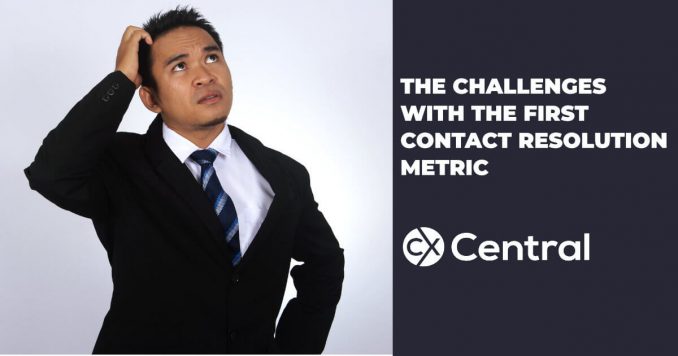
The Challenges with the First Contact Resolution Metric
Last week I chaired a panel of Judges for a number of Contact Centre Awards entries.
One of the Judges on our panel asked several of the entrants:
“So how do you measure your First Contact Resolution rate?” or
“Based on the initiative you’ve shared, what were there changes to your First Contact Resolution rate?”
So that got me to thinking.
Is First Contact Resolution – or ‘FCR’ – still relevant in today’s Contact Centre?
First Contact Resolution is a multivitamin KPI
When I teach operations I suggest Participants look at First Contact Resolution metric as a multivitamin KPI.
That’s because it does a few things for you.
FCR helps you to:
- Improve Customer Satisfaction (through reduction of Customer effort)
- Reduce cost (through a reduction in unnecessary repeat contact volume)
- Improve future Service Level (through a reduction in unnecessary repeat contact volume)
No wonder FCR is referred to with such reverence in the Contact Centre industry.
The First Contact Resolution Metric has always been hard to measure
I’ve seen First Contact Resolution formulas out there that would put Einstein’s formulas to shame.
They’re complex and require a lot of internal communication to understand and apply.
So, it’s worth considering why that’s so.
Everyone gets the general idea around FCR.
Assist the Customer to the degree that they won’t need to contact you again. It sounds easy.
But the practical application is more complex, in part because there’s no industry standard for how to measure FCR.
Push-button KPIs
Many Contact Centre KPIs are push-button KPIs.
Push the button and you get your result.
Push the button and get your Service Levels.
Push the button and you get your AHT.
Push the button and get the Occupancy rate.
You get the general idea.
But there’s no button to press for FCR. It falls into the category best called ‘assembly-required KPIs’.
Think of some other assembly-required KPIs for a moment.
Employee Engagement, Customer Satisfaction, Turnover Analysis are all good examples.
To get at the data for these KPIs you can’t just push a button.
Getting at assembly-required KPIs requires you to design & implement a solid methodology for data collection & analysis.
Common data sources for First Contact Resolution
When it comes to FCR data collection, common sources include:
- Allow Agents to rate their own performance (not really recommended for obvious reasons)
- Ask Quality Assurance folks to weigh in on FCR when they do their evaluations (this can be powerful and more on this soon)
- Survey Customers and ask them if their need was met (but aren’t Customers getting tired of getting surveyed and is this the right question to ask?)
- Run scans across the CRM system to see if a single Customer record shows multiple contacts for the same ‘reason’ within X time frame (based on business assumptions)
- Use operational data (when the nature of the interaction is very transactional such as tracking shipments)
And because there are pros & cons to each data source, you choose multiple data sources, assign a weightage to each one and assemble the results together to get an outcome.
The purpose of blending different sources together is to alleviate the inherent advantages & disadvantages of each individual source.
I think of it like making a stew.
You have to select a variety of ingredients, throw them into a pot in the appropriate ratios, stir well and season to taste.
So how can we address some of this complexity?
It helps to remember that FCR is ultimately a measure of quality.
Sure – it helps reduce unnecessary repeat contacts.
But at its heart Centres pursue FCR to help Agents create great conversations with Customers. Conversations that address spoken and unspoken needs – not just deliver transactional answer-based service.
So with that direction in mind, how can we improve our FCR delivery while mitigating the complexity inherent in assembly-required KPIs?
Define what First Contact Resolution looks like for each of your Top 10 enquiry types
Every inbound Centre has a Top 10.
The Top 10 ‘reasons’ a Customer contacts you.
While the Top 10 changes over time, these enquiries easily represent 60% – 80% of your total contact volume (excluding one-off events of course).
So rather than looking for a magical or ‘industry standard’ FCR rate, take your FCR magnifying glass down to the enquiry type.
For example, if your Enquiry Type #1 = Questions on room rates you’d sit down with a small group of folks and consider what FCR can and would look like.
What has to be conveyed, whether explicitly asked for or not, in that conversation.
But be careful.
Except for highly transactional Centres or enquiries you can’t rely exclusively on your internal determination of what FCR would look like. You’re going to have to consider a First Call Resolution metric from the Customer perspective as well.
And here I always suggest you do some qualitative research. Bring in some real Customers. Buy them lunch.
Ask them about their needs, expectations & wants (both expressed and unexpressed) when they ask about room rates.
I don’t see how we can talk about Customer-centricity without actually talking to real customers face to face.
There seems to a tremendous amount of fear or scepticism or just a plain lack of know-how around qualitative research.
That’s an article for another day.
Not every enquiry type might ‘qualify’ for First Contact Resolution
By the way – it may turn out the some of your Top 10 can’t be FCR for some reason. That happens.
But in these cases, I ask myself what has to be conveyed or gathered in that conversation to make it as effective as possible – even when the overarching goal of FCR can’t be achieved from the Customer’s perspective.
Earlier this year a Contact Centre Manager from a travel company told me that FCR is a mindset and that mindset training would be enough to raise the FCR rate.
But I disagreed (and disagree).
Yes – having a vision for FCR and putting it front and centre in your Agent’s performance basket matters. But it’s not enough.
You’re going to have to get a bit more granular – and the Top 10 approach is a practical way to do that.
Ask yourself – does my current metrics system align to First Contact Resolution?
Contact Centres are important touchpoints within an organization. But sometimes that very (self) importance leads to decisions which are good for the Centre but not necessarily good for the Customer.
Let me explain what I mean from a metrics perspective first.
If your Centre focuses heavily on Average Handling Time (AHT) as an Agent efficiency metric or on # of calls produced by the Agents you’re not really considering the Customer journey – you’re looking at what’s good for you.
Short call = lower cost (goes the reasoning).
That’s a touchpoint perspective.
FCR by its nature implies that we take the time needed to get the job done.
To provide the Customer with what they should know – whether explicitly asked for or not.
I’ve written extensively on Average Handling Time but for purposes of this article – if due to your Centre’s metrics perspective your Agent is more focused on quantity or time taken, it’s quality that takes the hit – and that includes a hit to FCR.
Don’t get me wrong – cost efficiency is great. But every financial model I’ve worked shows that a reduction in future unnecessary contacts saves more $$ overall than trying to shave 30 seconds off current calls.
Customers think in Journeys – not in Touchpoints
McKinsey writes that Customers think in journeys – not in touchpoints.
There’s a beginning, a middle and an end to a journey.
Some journeys go from start to finish and never touch the Contact Centre.
For other journeys, the Contact Centre is a key participant – and important to the Customer’s overall perception.
In Service Design, you learn that the various touchpoints need to work in harmony together – to avoid dissonance or distress.
So it makes sense to evaluate that harmony across the journey – not just what happens ‘inside’ the Centre.
Have your Agents been trained on Customer journeys?
I don’t mean journey mapping – that’s not needed at the Agent or Team Leader level.
I’m talking about sharing the motivations and experiences that led to the Customer contacting the Centre.
What was their mood, what was their ‘job to be done’ – what was the role of the Centre in helping the customer achieve their goals?
On the other side of the interaction – where will the Customer go next in their journey?
Is there some way we can help them accomplish that better?
What can the Centre bring to the table to deliver a standout role in the Customer journey?
When I do Frontline training I often ask – “Do you know what your music on hold is?” or “Have you experienced your own IVR? Your own Delay Announcements?”.
Because the Customer Experience doesn’t begin when you start talking (or typing).
It begins earlier upstream.
Nine times out 10 the Agents hadn’t spent time studying the Contact Centre journey – much less the Customer journey.
I think this represents a real opportunity.
Should you pursue a First Contact Resolution metric ?
My personal belief system around First Contact Resolution is this.
It doesn’t make sense to implement an elective process where the costs and effort of the process aren’t outweighed by the benefits delivered by the process.
If you can prove out that your complex but solid methodology to get at metric-oriented FCR is yielding dividends – then by all means go for it. Just keep Quality as your North Start for putting together your FCR program – it should always be aligned to what the Customer would say.
So I’m never surprised or judgemental when I meet Centres that don’t specifically measure FCR. That puts me into the minority I think.
Alternatively, I see some Centres take a less metric-driven approach to FCR.
But one that’s also quite effective.
They build the concept of FCR into their Service Vision & Principles – essentially a set of statements that answer the question – “What kind of service do we deliver around here?”.
For example, if one of their Service Principles is ‘to be helpful’ – they consider all the ways they can be helpful to Customers (and each other) across all interactions.
The successful behaviours that enable being helpful become codified across the Centre. The use of the Top 10 enquiry type approach works wonderfully here.
And these helpful behaviours are picked up in the normal Contact Centre monitoring processes through Quality Assurance, Team Leaders, Mystery Shopper providers and the like.
In closing
I think the First Call Resolution metric still has relevance in today’s Contact Centre.
But not as some ‘industry-standard’ metric.
Rather it should represent an approach to how we serve customers – and each other – in general.
Thanks for reading!
Recommended further learnings:
- Read: Why the AHT metric should be killed off
- Upskill: Search our courses for contact centre managers >
- CX Glossary: First Call Resolution
- Read: The 5 best KPI’s for your call centre


Be the first to comment